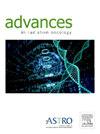Early Outcomes from Proton Craniospinal Irradiation for Leptomeningeal Metastasis From Solid Tumors
IF 2.7
Q3 ONCOLOGY
引用次数: 0
Abstract
Purpose
Treatment options for leptomeningeal metastasis (LM) are limited. A recent phase 2 study found that proton craniospinal irradiation (pCSI) was well-tolerated and improved survival. We report our experience with pCSI for solid-tumor LM.
Methods and Materials
This is a retrospective review of patients treated with pCSI for solid-tumor LM from December 2020 to January 2024 at our center. Patient characteristics were summarized using descriptive statistics. Median overall survival and median central nervous system progression-free survival from the first day of pCSI were estimated using Kaplan-Meier survival curves.
Results
We identified 45 patients who completed pCSI. The median age was 54 years (range, 23-79); 73% were female, and 53% lived more than 100 miles from our center. Breast cancer (53%), lung cancer (20%), and melanoma (9%) were the most common primary cancers; 51% of patients had stable systemic disease at LM diagnosis. All had imaging evidence of LM, and 64% of cases were confirmed using cytologic examination of the cerebrospinal fluid. Eighty percent had symptomatic LM, and the median Karnofsky performance scale at LM diagnosis was 80. The median time from primary cancer diagnosis to LM detection was 23.1 months (range, 0-221.3). Fifty-three percent of patients had active brain metastasis at LM diagnosis; 33% of all patients had received prior intracranial radiation. The median time from simulation to pCSI start was 12 days. At the first visit following pCSI, the median Karnofsky performance scale score was 70. During or right after radiation, 76% of patients reported nausea, 51% headache, and 31% fatigue. Following pCSI, 4% received intrathecal chemotherapy, 67% systemic therapy, and 9% hospice care; 18% were observed and 2% lost to follow-up. Median overall survival was 13.7 months (95% confidence interval [CI], 11.2 to not reached), and median progression-free survival was 6.5 months (95% CI, 4.9-12.8).
Conclusions
The outcomes in our cohort are comparable to those recently reported in a phase 2 trial. Further study is indicated to determine the optimal candidates for pCSI and sequential therapies.
质子颅脊髓照射治疗实体瘤轻脑膜转移的早期疗效。
目的:小脑膜转移(LM)的治疗选择是有限的。最近的一项2期研究发现,质子颅脊髓照射(pCSI)耐受性良好,可提高生存率。我们报告用pCSI治疗实体瘤LM的经验。方法和材料:本研究回顾性分析了2020年12月至2024年1月在我中心接受pCSI治疗的实体瘤LM患者。采用描述性统计方法总结患者特征。使用Kaplan-Meier生存曲线估计pCSI第一天起的中位总生存期和中位中枢神经系统无进展生存期。结果:我们确定了45例完成pCSI的患者。中位年龄为54岁(范围23-79);其中73%是女性,53%的人住在离我们中心100英里以上的地方。乳腺癌(53%)、肺癌(20%)和黑色素瘤(9%)是最常见的原发癌症;51%的患者在LM诊断时有稳定的全身性疾病。所有病例均有LM影像学证据,其中64%的病例通过脑脊液细胞学检查得到证实。80%有症状性LM, LM诊断时Karnofsky表现量表中位数为80。从原发性癌症诊断到LM检测的中位时间为23.1个月(范围0-221.3)。53%的患者在LM诊断时有活动性脑转移;33%的患者之前接受过颅内放疗。从模拟到pCSI开始的中位时间为12天。在pCSI后的第一次访问中,Karnofsky绩效量表得分中位数为70。在放疗期间或放疗后,76%的患者报告恶心,51%的患者报告头痛,31%的患者报告疲劳。pCSI后,4%接受鞘内化疗,67%接受全身治疗,9%接受临终关怀;18%的人被观察到,2%的人失去了随访。中位总生存期为13.7个月(95%可信区间[CI], 11.2至未达到),中位无进展生存期为6.5个月(95% CI, 4.9-12.8)。结论:我们队列的结果与最近报道的2期试验的结果相当。进一步的研究表明,以确定最佳候选人的pCSI和顺序治疗。
本文章由计算机程序翻译,如有差异,请以英文原文为准。
求助全文
约1分钟内获得全文
求助全文
来源期刊

Advances in Radiation Oncology
Medicine-Radiology, Nuclear Medicine and Imaging
CiteScore
4.60
自引率
4.30%
发文量
208
审稿时长
98 days
期刊介绍:
The purpose of Advances is to provide information for clinicians who use radiation therapy by publishing: Clinical trial reports and reanalyses. Basic science original reports. Manuscripts examining health services research, comparative and cost effectiveness research, and systematic reviews. Case reports documenting unusual problems and solutions. High quality multi and single institutional series, as well as other novel retrospective hypothesis generating series. Timely critical reviews on important topics in radiation oncology, such as side effects. Articles reporting the natural history of disease and patterns of failure, particularly as they relate to treatment volume delineation. Articles on safety and quality in radiation therapy. Essays on clinical experience. Articles on practice transformation in radiation oncology, in particular: Aspects of health policy that may impact the future practice of radiation oncology. How information technology, such as data analytics and systems innovations, will change radiation oncology practice. Articles on imaging as they relate to radiation therapy treatment.
 求助内容:
求助内容: 应助结果提醒方式:
应助结果提醒方式:


